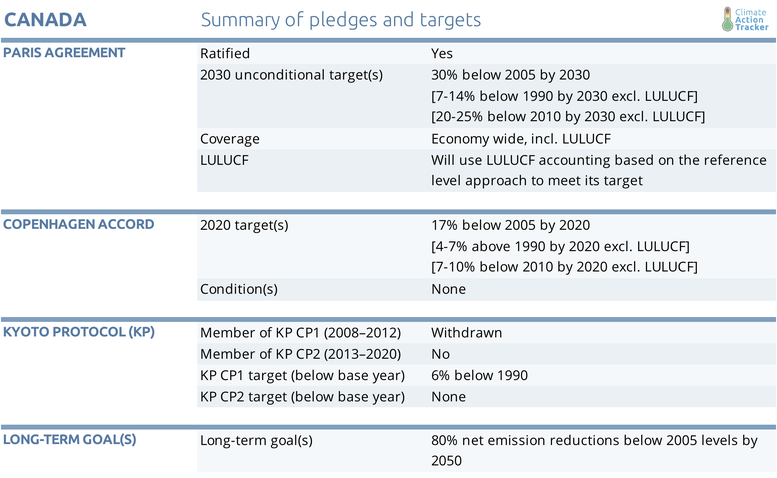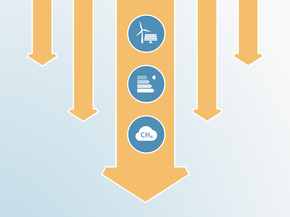Pledges And Targets
Summary table

Paris Agreement targets
Canada states in its NDC that it will pursue an economy-wide target to reduce GHG emissions to 30% below 2005 levels by 2030. A 30% reduction of 2005 levels excluding LULUCF equates to 511 MtCO2e and is equivalent to a 15% reduction below 1990s.
Canada has now quantified the projected extent of its LULUCF contribution towards meeting its 2030 target, though it noted that these figures should be viewed as ‘preliminary and provisional’ (Environment and Climate Change Canada, 2018a, p. 33). Canada will apply the “Reference Level Approach” to LULUCF accounting. The accounting contribution could range from 7-46 MtCO2e depending on if harvest rates are high or low. When credits from LULUCF accounting are excluded, Canada’s total emissions in 2030 would be 518-557 MtCO2e, which represents a 24-29% reduction below 2005 levels or 7-14% reduction below 1990 levels.
This target emissions level corresponds to a CAT rating of “Insufficient.” In past assessments, the CAT has downgraded Canada’s NDC rating due to the lack of clarity around the extent to which the country would rely on its forestry sector sink to meet its target. Given the clarity on the LULUCF accounting contribution, the CAT no longer downgrades Canada’s rating.
It is worth noting that Canada uses “the IPCC production approach” to account for Harvested Wood Products (HWPs). Under this approach, emissions associated with wood from forest harvest and forest conversion activities are included in the country’s GHG inventory, irrespective of whether the products stay within the country or are exported. Accounting for HWPs must be performed in a consistent and compatible manner across countries so that accounting of imported and exported HWPs is complete, and emissions are not excluded from inventories (Macey, Hare, & Chen, 2011).
Canada excludes emissions from natural disturbances (e.g. forest fires and insect outbreaks).
Canada has indicated that it may also use international credits to meet its target (Carr, 2018). Considering the upward trajectory of the upper bound of the current policy projection, Canada may need to use a large quantity of international credits to meet its target. It has included 13 MtCO2e in credits from the Western Climate Initiative into some of its projections and is part of the World Bank’s Transformative Carbon Asset Facility, an initiative aimed at a piloting carbon market mechanism under Article 6 of the Paris Agreement (World Bank, n.d.).
2020 pledge and Kyoto Protocol
Canada's Kyoto Protocol target for the first commitment period 2008–2012 was a reduction of 6% below 1990 levels. However, in December 2011, Canada withdrew from the Kyoto Protocol.
Canada's Copenhagen pledge aims to reduce emissions by 17% below 2005 levels by 2020. The Copenhagen commitment aligned Canada’s level of ambition to the United States, which also has a target of 17% reduction in emissions from 2005 levels by 2020. This contribution from LULUCF accounting towards meeting this target is estimated to range from 19-41 MtCO2e depending on harvest rates are high or low. When credits from LULUCF accounting are excluded, Canada’s total emissions in 2020 would be 625-647 MtCO2e, which represents a 11-14% reduction below 2005 levels or 4-7% increase above 1990 levels.
Long-term goal
In 2016, Canada proposed a mid-century, long-term low greenhouse gas development strategy (Government of Canada, 2016a). This strategy contains an emissions reduction pathway that is consistent with net emissions falling by 80% in 2050 from 2005 levels. The strategy documentation indicates that this target equates to a 65% reduction in emissions below 2005 levels excluding LULUCF, with the remainder to be achieved through sequestration in the land sector and international credits (Government of Canada, 2016a). Canada intends to regularly update this long-term strategy as national circumstances change and low-GHG technologies evolve.
Further analysis
Latest publications
Stay informed
Subscribe to our newsletter




